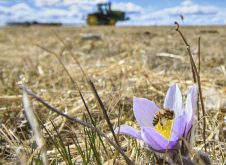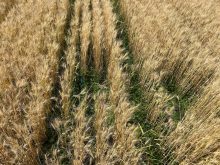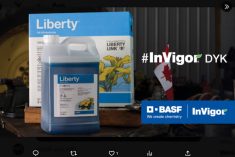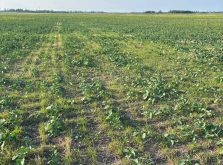The 2022 growing season was a “monstrous” year for canola farmers battling flea beetles in some parts of the Prairies.
James Tansey, an entomologist with the Saskatchewan Ministry of Agriculture, shared that assessment with a crowd of producers, agronomists, agri-retailers and other industry representatives at Saskatchewan’s Agronomy Research Update 2022, held last December in Saskatoon.
Tansey said the flea beetle problem was particularly significant in eastern sections of northeast Saskatchewan and southern portions of Manitoba. It was so bad in those areas that some producers used three and sometimes four foliar insecticide applications to manage flea beetles.
Read Also

Claas brings 1000 Series SP forage harvesters to Canada
In mid-August, Claas unveiled its new line of Jaguar forage harvesters at an event in Visalia, California, deep in the heart of that state’s dairy region.
While individual flea beetles don’t cause much damage to plants, Tansey said there can be “bajillions” in a field at a given time and they can collectively cause significant damage in short order.
His presentation at the two-day conference focused on the efficacy of insecticide seed treatments for flea beetle control in canola as well as other solutions available to growers.
Neonicotinoids
Most canola seed planted on the Prairies is treated, and in many cases includes some form of neonicotinoid, a class of neuro-active insecticides similar to nicotine. Neonicotinoids are Group 4A insecticides.
Popular and effective Group 4A insecticide seed treatment options last season were those containing the active ingredient clothianidin. Clothianidin is available in several products including Nipsit Inside 600, Poncho 600 FS, Prosper EverGol and Vercoras, a pre-pack mixed with other non-insecticidal components.

Cyantraniliprole is the active ingredient in products like Lumiderm (mixed with Prosper EverGol or Helix Vibrance) and Fortenza (mixed with Vibrance 500 FS), and is primarily an anti-cutworm agent, but Tansey said it is also an effective tool against flea beetles. Cyantraniliprole is one of the active ingredients in Group 28 insecticides.
Flupyradifurone is another relatively new active ingredient that can be found in Buteo Start 480 FS seed treatment from Bayer CropScience. The manufacturer of the Group 4D insecticide calls it a “powerful protection” for canola seed against flea beetle pressure.
Tansey said initial reports have been positive for flupyradifurone. He said it works by binding to the same receptor site as a Group 4A chemical, but it’s structurally different enough to be considered a different subgroup.
The active ingredient sulfoxaflor is also effective for flea beetle control, especially when it is part of a co-pack with a product like Fortenza Advanced. Fortenza Advanced is a co-pack of Rascendo and Fortenza. Rascendo is a 4C insecticide with the active ingredient sulfoxaflor and Fortenza is a Group 28 insecticide with the active ingredient cyantraniliprole.
The active ingredients imidacloprid and thiamethoxam (both Group 4A insecticides) can be found in Sombrero 600 FS and Helix Vibrance, respectively, and are both effective against flea beetles, Tansey said.
However, he said it’s important to note that different flea beetle species can react differently to insecticide treatments. For example, striped flea beetles seem less sensitive to some insecticidal compounds.
Tansey said temperature can play an important role in the amount of damage flea beetles can cause to a canola crop. Both crucifer and striped flea beetles do most of their damage in warm (30 C) conditions. However, striped flea beetles are less tolerant of heat and activity begins to diminish in this species at about 26 C.
Still, Tansey said most seed treatments are effective in reducing feeding damage. That includes Group 28 compounds, which he said are used primarily for cutworm control but also “pack quite a punch” when it comes to managing flea beetles.
Foliar products: availability concerns
Availability of some foliar products is a potential concern for flea beetle control in 2023.
That could be particularly true with some Group 3 foliar insecticides, Tansey said. A recent ruling by the federal Pest Management Regulatory Agency prohibits the use of products with the active ingredient lambda-cyhalothrin (Group 3) on feed and forage crops.
This prompted manufacturers to re-label products and some were recalled. Until April 21, 2023, it was thought neither Matador nor Voliam Xpress from Syngenta would be available during the growing season. Recently, Syngenta Canada announced limited amounts of Matador 120EC and Voliam Xpress insecticides will be released in Western Canada, but the focus of the products will be on horticulture and pulse crops for the 2023 growing season. However, Adama’s Silencer and Zivata and Sharda CropChem’s LaBamba are available.
Although the use of these products is permitted on the oilseeds canola and mustard, they are not allowed on these crops if meal is intended for animal feed.
Several other Group 3 foliar insecticides are permitted for use on these crops. Insecticides with the active ingredient permethrin (Pounce, Perm-Up, IPCO Syncro, Ambush), cypermethrin (Up-Cyde 2.5 EC, Ship 250 EC) and deltamethrin (Decis 100 EC, Decis 5 EC, Advantage Deltamethrin 5 EC, Poleci) are examples of Group 3 foliar insecticides for flea beetle control.
Group 1A insecticides with the active ingredient carbaryl (Sevin XLR) and Group 1B insecticides with the active ingredient malathion (Malathion 500, Malathion 85E) are also available and remain effective against flea beetles.
Field study
Tansey highlighted the results of a strategic field study program funded by the Saskatchewan agriculture ministry. Its purpose was to study several different canola seed treatment options available at the time (2019) to determine their effects on damage assessments, yields and time to maturity.
Products included Lumiderm, Helix Vibrance, Helix plus JumpStart, Prosper, Visivio, and Helix plus Lumiderm. Also included in the study were a control and fungicide only treatments.
Three small-plot research trials were established by Agriculture Applied Research Management (Agri-ARM) collaborators near Scott, Outlook and Yorkton, Sask. A large-plot trial was also established by Tyler Wist at two Agriculture and Agri-Food Canada experimental farms in the province.
The latter test examined the effects of seed treatment application to borders around fields and compared the effects of whole-plot, 30-foot borders and 60-foot borders of commercial neonicotinoid seed treatments for damage, yield and time to maturity.
Tansey said the group that included the Helix plus Lumiderm combination and Helix Vibrance appeared to offer the best control of flea beetle damage compared with the control and straight fungicide.
Treatments that included Visivio, Prosper and Helix plus Jumpstart were only slightly less effective. Even Lumiderm, which is a Group 28 insecticide and primarily used for cutworm control, reduced flea beetle damage compared with the control and fungicide offerings.
Results of large-plot work indicated greater seedling damage in plots with 30-foot border strips than fully treated plots and untreated canola was later to mature. Tansey noted study results may have been slightly skewed due to dry conditions in 2019 and flea beetle pressures were low at that time.
Other options
While seed treatment and foliar insecticides are effective tools against flea beetles, Tansey said there are other options to reduce flea beetle damage to canola. One is to plant seeds as shallow as available moisture will allow, to promote rapid germination and quick emergence.
Another is to seed into standing stubble, which can protect seedlings early in development. Increased seeding rates — which can mean a greater number of plants and less damage per plant — and wider row spacings of 20 to 30 centimetres can also help, he added.
Early seeding is another option. Tansey said the main benefit is early seeding helps plants get to the four-leaf stage before flea beetles become very active and cause the most damage.
However, growers who seed a little later have also obtained good results, so the jury is still out on the best time to plant.
Tansey noted a recent shift in the composition of flea beetle species in Saskatchewan. In some regions, the dominant species has shifted to striped flea beetles from crucifer flea beetles in recent years. It’s thought that shift is driven in part by the striped flea beetle’s greater tolerance of some insecticides.
However, the crucifer flea beetle came “roaring back” this past year in and around Saskatoon. This might be due to its greater tolerance of hot, dry conditions than its striped counterpart.
















